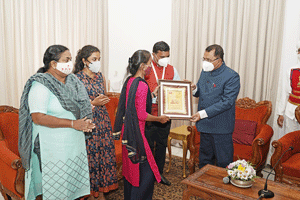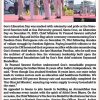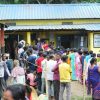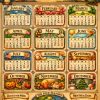Goa is abuzz with excitement as vintage bike and car owners, users, collectors and fans are decking […]

Standing united in the Fight against HIV By Janice Rodrigues
Aids Day, December 4, 2021 December 3, 2021To mark World AIDS Day on December 1, 2021, Governor of Goa P S Sreedharan Pillai treated vulnerable children and adolescents, along with the Human Touch Foundation team at the Raj Bhavan.
By Janice Rodrigues
Every year the world comes together on December 1, to commemorate the lives lost and those affected by the world’s longest running epidemic. On the World AIDS Day, the United Nations remembers those who have died of AIDS related illness, to support people living with HIV (PLHIV), to celebrate achievements made in resolving the epidemic in the sphere of HIV/AIDS and to raise awareness and to unite to combat the spread of the virus.
Forty long years have gone by since the first case and yet there seems no respite in sight. So, as we enter the fifth decade of the HIV/AIDS epidemic, we ask ourselves ‘Why is it so difficult to fight this virus?’ Globally we have seen a lot of advancement in the HIV response, yet in India we are still lagging behind.
According to UNAIDS, though there was 30% decline in new HIV infections since 2010, despite this an estimated 1.5 million individuals have acquired HIV in the year 2020. “India was estimated to have around 57,550 new HIV infections in 2020, 10 percent of which were in children below 15. Though this is a huge decline from the peak in 1997, it is still alarming! The numbers in Goa are even more so, given the area and population, at 158 new infections in 2021 (till September) alone, with Mormugao and Salcete showing the highest number of cases. This indicates that there is still lack of awareness and gap of knowledge,” says Applesta da Costa, Progam Lead for Psycho-social Support, Human Touch Foundation.
Out of the 1.5 million individuals, approximately 1,60,000 new infections were found among children below the age of 15, even as prevention of childhood HIV infections has been made possible through Prevention of Mother to Child Transmission (PMTCT) strategies. These strategies ensure that the virus is not transmitted from the mother to child during pregnancy, labour and breastfeeding.
In other efforts, science has advanced to a stage where a person living with HIV can reach an undetectable viral load through adherence to treatment regimes. There is a global movement called the ‘U=U’ (Undetectable = Untransmittable), which means that a person who achieves and maintains an undetectable viral load cannot sexually transmit the virus to another. Additionally, the use of drugs like Pre-Exposure Prophylaxis (PrEP) and Post Exposure Prophylaxis (PEP) has also been introduced as a preventative tool that can be administered to individuals who are at a high risk of acquiring HIV. While PEP is often used in medical settings especially in case of rape, PrEP is a fairly recent entry into India. However, despite these successes in science, the lack of awareness about HIV often acts as a barrier for individuals to protect themselves and their loved ones from being infected.
MANAGABLE AILMENT
While adolescents and young people who are positive face hurdles of growing up with the Virus, adults on the other hand, face issues ageing with it. Previously, HIV was associated with inevitable and immediate death, but today it is gained the status of a manageable chronic illness. Ever since the introduction and access of free anti-retroviral therapy, we can now see the first generation of epidemic survivors who are growing up and growing old. The prospect of an increased lifespan gives them hope and raises their spirits to dream like any other. But the challenges pertaining health, education, social life, employment and so on continues.
They hesitate to seek support with a fear that the disclosure of their status will expose them to a life of difficulties and rejection in society. In keeping with this year’s theme for the World AIDS Day “End Inequalities. End Aids. End Pandemics”, there is an urgent need to end the inequalities and discrimination that further cause HIV AIDS and other pandemics to thrive around the world. In today’s times as well, we see a lot of discrimination to the young people who are living with HIV especially in the cases of jobs and academics,” says Applesta.
They often feel left behind in society, while authorities and other significant people have expressed concern surrounding COVID-19, little was vocalized regarding the impact of the Dual Pandemic i.e. COVID-19 and HIV. “Covid-19 has had a significant impact on PLHIV, limiting their access to treatment and care services, and the long term medications they so crucially rely on.
All through last year, they faced social, economic and public health challenges, with increased anxiety, and constant fear of contracting an additional virus, while living with a weakened immune system. Financial insecurity resulting from lockdown imposed-unemployment drove apprehensions surrounding food security and livelihood; and panic and chaos prevailed. In keeping with this year’s theme we are trying our best to alleviate the trials of community in whatever way we can,” says Applesta.
It is thus necessary to educate people about HIV, express solidarity with people living with the virus, encourage testing, demand for care and treatment services and promote better health care systems. This will bring us closer to the UNAIDs 90-90-90 global HIV target to help end the epidemic. This target states that 90% of all people living with HIV will know their status, 90% of all people living with HIV will receive treatment, and 90% of all receiving treatment will suppress the virus in their body.
About the Organisation
Human Touch Foundation has been catering to unmet needs of Adolescents and Young People Living with HIV (A&YPLHIV), while engaging in a comprehensive and sustained approach through a community based model, addressing barriers that these people face while coping with HIV. Since they are at a higher risk of developing mental health issues associated with HIV, the organization through psychosocial support, also provides a safe space for young people living with HIV to express their concerns, build resilience and achieve an optimum level of well-being.















